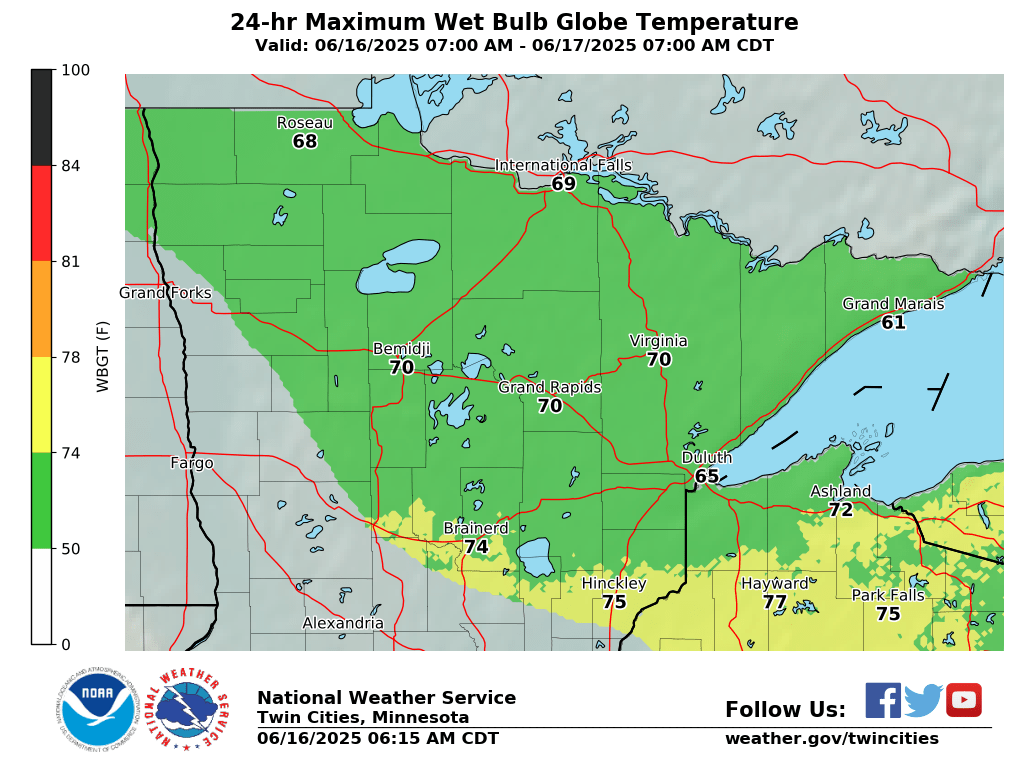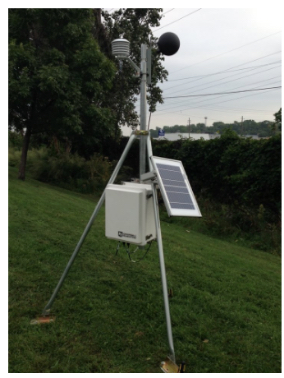Current conditions
Forecast


| Very low | Low | Moderate | High | Extreme | |
|---|---|---|---|---|---|
| Active persons heat index (APHI) | 1 | 2 | 3 | 4 | 5 |
| Wet Bulb Globe temp (WBGT) | 77-79°F | 80-82°F | 83-85°F | 86-88°F | >88°F |
| Suggested precautions | Normal activities Begin to monitor at risk persons |
Use discretion for intense or prolonged exercise | Limit duration of outdoor activities to two hours or less | Limit duration of outdoor activities to one hour or less | Cancel outdoor workouts and exercise |
| Recommended breaks in shade (per hour of activity) | As needed | 15 minutes | 30 minutes | 45 minutes | Do not resume until the index lowers |
The Wet Bulb Globe Temperature (WBGT) is a measure of the heat stress our body feels in direct sunlight. The WBGT takes temperature, humidity, wind speed, sun angle, and cloud cover (solar radiation) into account. The WBGT is more comprehensive in determining how our bodies respond to the heat outside as opposed to the Heat Index which is much more commonly known. You can see by the chart below the differences in what measurements go into WBGT versus what is used for the Heat Index.

| WBGT | Heat index | |
|---|---|---|
| Uses temperature | X | X |
| Uses relative humidity | X | X |
| Uses wind | X | |
| Uses cloud cover | X | |
| Measured in the sun | X | |
| Uses in the shade | X | |
| Uses wind | X |
The WBGT is useful for those who work or are active outside. The WBGT has been used for decades in many military agencies, by the Occupational Safety and Health Administration (OSHA), and by organizations that facilitate marathons. The WBGT is also what The American College of Sports Medicine bases its guidelines for the intensity of sport practices on, and is therefore utilized by athletic programs in many school districts.
Preparedness: On days with moderate or high WBGT Risk, take plenty of water breaks, slow down, and wear lightweight, light-colored clothing that reflects heat and sunlight. Also consider limiting the duration of your outdoor work/activities. On days where the WBGT Risk reaches the extreme category, consider canceling your outdoor work/activities. Also, always make sure you wear sunscreen.
Consequences of Extreme Heat: Extreme heat can be just as deadly as other natural hazards by pushing the human body beyond its limits. Under normal conditions, the body’s internal thermostat produces perspiration that evaporates and cools the body. However, in extreme heat and high humidity, evaporation is slowed and the body must work extra hard to maintain a normal temperature. There are different conditions, or disorders, related to extreme heat illnesses: sunburn, heat cramps, heat exhaustion, and heat stroke.